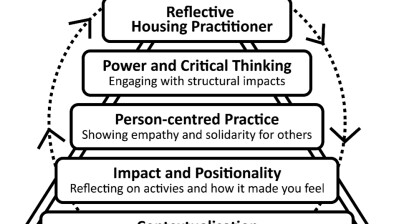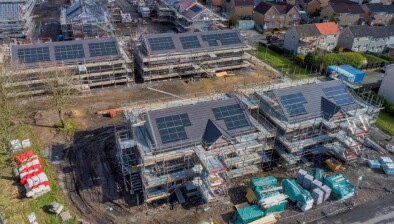Blog: Game Over? Game On!
 An article painting a bleak picture of housing associations in Scotland appeared recently in Bella Caledonia and was republished on the Scottish Community Alliance website. This picture, however, is at odds with the experience of many tenants and communities across Scotland, writes the Scottish Federation of Housing Associations (SFHA).
An article painting a bleak picture of housing associations in Scotland appeared recently in Bella Caledonia and was republished on the Scottish Community Alliance website. This picture, however, is at odds with the experience of many tenants and communities across Scotland, writes the Scottish Federation of Housing Associations (SFHA).
Without going into too much detail, the article suggests that housing associations have been used as a ‘Trojan Horse’ to privatise social housing and increase the financialisation of the sector.
If you look at the origins of housing associations in Scotland, rather than a ‘Trojan Horse’ intent on privatising public housing, you will see a community-led movement responding to very real housing need.
At a time when municipal housing was under-funded and under-valued, community-based housing associations were organising themselves, taking control over stock and renewing local communities.
Each housing association has followed their own path over the years. Some have remained small and heavily community-focused. Others have sought to improve access to affordable housing on a larger scale, operating in numerous local authority areas. However, they are all part of a wider social housing movement with a shared history and commitment to the future of Scottish social housing – and all have social justice as part of their DNA.
While it is true to say that some housing associations in other parts of the UK have adopted a different model, housing associations and co-operatives in Scotland are very firmly not-for-profit bodies, and the vast majority are charities. They are run by governing bodies made up of volunteers. Many board members in community-based housing associations are tenants, dedicated to making a difference in their local area.
Investment in Affordable, Social Housing

In recent times, around 2010, driven by ‘austerity’ and the perceived need to tighten the fiscal belt, the Scottish Government did reduce the level of investment given to housing associations towards development. This reflected choices made by politicians south of the border, where investment in truly affordable, social housing was not, and is still not prioritised by the UK government.
When this happened, the level of development plummeted as organisations that prioritise existing tenants and communities chose to reduce or cease development rather than take on more financial risk.
However, as the level of new build approvals plummeted, the Scottish Government recognised the need to invest in social housing. In 2015, a Housing Subsidy Review Group (including bodies such as SFHA, GWSF and COSLA) met to look at grant rates for social and affordable housing.
This led to a £12,000 increase in the average grant for a housing association homes, enabling housing associations to both increase the supply of quality social rented housing and to keep rents affordable.
This grant rise is significant in helping housing associations to work to deliver a target of 50,000 affordable homes (35,000 for social rent) in the current parliament – the highest level of social housing building since the 1970s.
This increase in grant rates, coupled with the abolition of the Right to Buy, signals a strong commitment to maintaining and increasing levels of social rented housing in Scotland – a commitment shared by the social housing movement and by local authorities.
Community Empowerment – Not Erasure of Public Housing

Housing associations exist to improve the quality of housing and quality of life for their tenants. Where stock transfers have taken place to housing associations, the aim has always been to regenerate places, invest in communities and improve tenants’ lives.
Can anyone honestly say that it would have been better for tenants in estates such as Castlemilk, Wester Hailes and Whitfield if housing associations had not worked to regenerate the estates and improve the housing conditions of tenants?
The article made detailed reference to the Wheatley Group and GHA – yet they have transformed estates and significantly improved homes – for example with the regeneration of Sighthill and with the district heating scheme and external wall insulation that improved affordablility and comfort at Broomhill.
Stock transfer to housing associations in these areas has not only brought about much needed investment, it has given people control of their communities and empowered them. Just as community based housing associations played a vital role in regenerating tenements mismanaged by private landlords in Glasgow and elsewhere in the 1970s and 80s, housing associations and co-operatives have regenerated and improved many failing peripheral estates.
“Housing associations have a commitment to social justice that can be seen in the services that they provide, such as housing support and energy advice.”
A number of housing associations have started providing ‘mid-market’ homes, for those families who would never be allocated a social rent home, but would struggle to pay private market rents. These households need to have their housing needs met, but the market fails them. Housing associations that have started to offer mid-market rent homes are not doing this instead of social rent homes – but are finding ways to marshal investment to provide good quality affordable homes within the communities they operate in. It demonstrates the way in which they are responding to the needs of the families living in their local areas. While this is an important area of work for housing associations, providing housing for social rent remains the priority for our members – they are the main providers of new build housing for social rent in Scotland.
Housing associations have a commitment to social justice that can be seen in the services that they provide, such as housing support and energy advice, (they have the most energy efficient homes in Scotland, keeping their homes affordable for tenants to heat). Housing associations are in it for the long haul – many have housed generations of tenants and fund adaptations to enable tenants to continue to live at home as their needs evolve.
The Scottish housing association movement is not above criticism; where poor practice exists it must be challenged. Good practice must be shared, and more can be done to empower tenants and communities.
However, it is unhelpful to publish unfounded and unresearched assumptions about how the social housing sector operates in one part of the UK based on knowledge of other parts. The context is very different.
Housing associations are keen to share and promote the good work that they do, and would welcome the opportunity to showcase their work. The invitation is there.
The Glasgow and West of Scotland Forum of Housing Associations has offered its own response to the article here.
This blog was originally published on the SFHA website.








